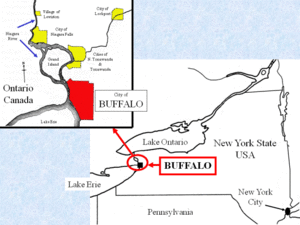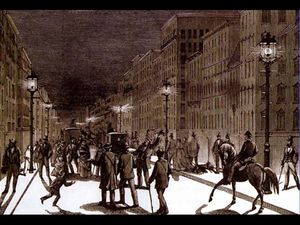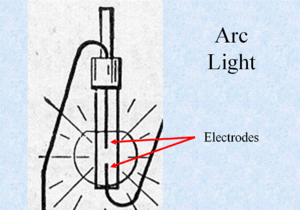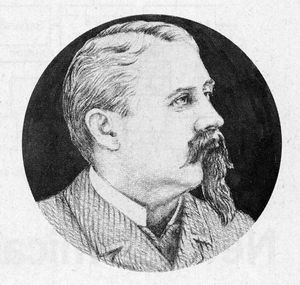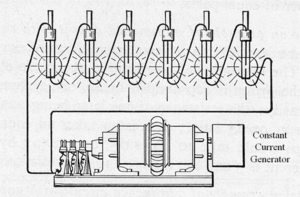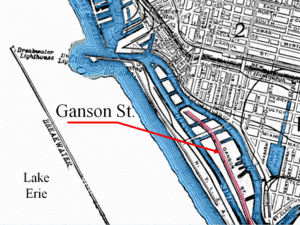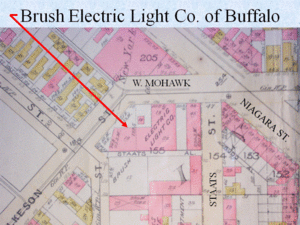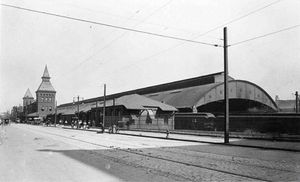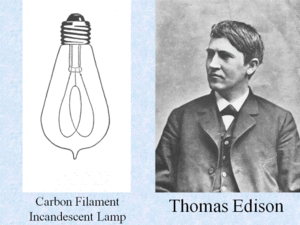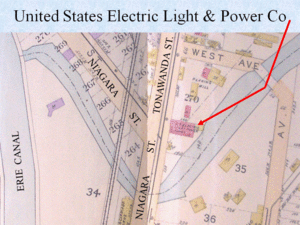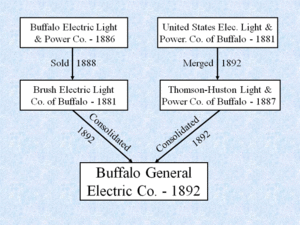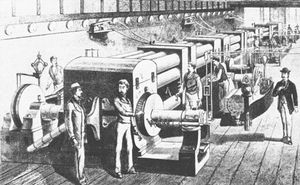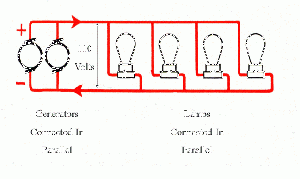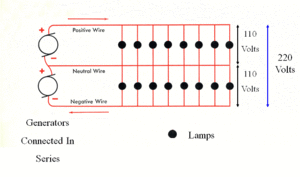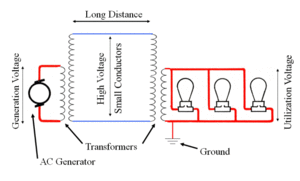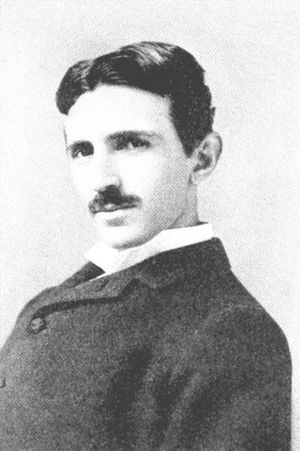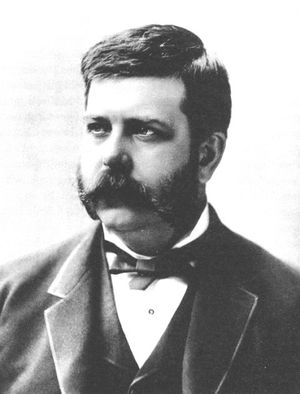Early Electrification of Buffalo: Difference between revisions
No edit summary |
No edit summary |
||
| Line 1: | Line 1: | ||
== The Beginning of Central Station Service == | |||
[''NOTE: This is Part 1 of a fourteen part series of articles first developed as a PowerPoint presentation by Craig A. Woodworth, IEEE Life Member (a.k.a Cawoody), for a joint meeting of the [[IEEE Buffalo Section History|Buffalo Section IEEE]] and the Buffalo & Erie County Historical Society on April 14, 2004''.] | |||
See also: | See also: | ||
| Line 42: | Line 44: | ||
ix. ''Niagara Mohawk Story'', 75. | ix. ''Niagara Mohawk Story'', 75. | ||
[[Image:02-Pearl St. Station-15.jpg|thumb|left|Figure 2.1 Pearl Street Station]] | |||
This article is Part 2 of a 14 Part series. | |||
Previous: [[Early Electrification of Buffalo: The Beginning of Central Station Service|Part 1 of 14: Early Electrification of Buffalo: The Beginning of Central Station Service]] | |||
In September 1882, the Pearl Street Station of the Edison Electric Illuminating Company in New York City went into operation serving 85 customers with some 400 incandescent lamps [Fig. 2.1]. This central station system, which was designed to serve an area approximately one-mile square, consisted of constant voltage direct current [[Generators|generators]] connected in parallel serving radial circuits with lamps connected in parallel.<sup>i</sup> 110 volts was selected on the basis of economics with copper being the [[Image:02-Edison Central Station-DC System-16.GIF|thumb|Figure 2.2 Edison Central Station DC System]]largest cost [Fig. 2.2].<sup>ii</sup> It is remarkable that in the last century the voltage has been adjusted upward only slightly to today’s standard of 120 volts. | |||
The next important development came less than one year later in July 1883 when a three-wire system went into operation in Sunbury, Pennsylvania with a 62 1/2 percent saving in copper compared to the New York system [Fig. 2.3].<sup>iii</sup> To serve the same [[Image:02-Edison Central Station 3 wire dc system-17.GIF|thumb|Figure 2.3 Edison Central Station three wire DC system]]load with two generators connected in series, the current is cut in half. The neutral current is zero with equal loads on both generators. Direct current systems had three major disadvantages: | |||
#Generation had to be located reasonably close to the load due to the voltage drop, which required large size wire. | |||
#Generation had to be at utilization voltage. | |||
#Low utilization voltage meant high currents and high currents meant high losses in the distribution lines. | |||
[[Image:02-alternating current system-21.GIF|thumb|left|Figure 2.4 Alternating Current System]]The adoption of alternating current systems overcame these disadvantages. While Edison was improving the dc system, others were developing the alternating current system, which, by using [[Transformers|transformers]], could raise the generation voltage and utilize small conductors for distribution, then lower the voltage for loads remote from the generation [Fig. 2.4]. The safety problem of a transformer insulation breakdown applying high-voltage to the secondary was solved by the simple but effective expedient of grounding the transformer secondary winding.<sup>iv</sup> | |||
== Advent of Alternating Current == | |||
The first alternating current central station to operate commercially in the United States was placed in service in Buffalo on November 30, 1886 only four years after Edison’s Pearl Street Station. It was a Westinghouse 400 lamp single-phase (or two-wire) system with a primary of 1000 volts. The generator was located in the Brush Electric Light plant at Wilkeson and Mohawk Streets. One customer was the Adam, Meldrum & Anderson department store on downtown Main Street, now the site of the Main Place Mall.<sup>v</sup> | |||
[[Image:02-tesla-23.jpg|thumb|left|Figure 2.5 Nikola Tesla]]The following year in Montpelier, Vermont an ac system replaced a dc system and [[Image:02-Westinghouse-24.jpg|thumb|right|2.6 George Westinghouse]]the value of the copper salvaged was enough to cover the cost of conversion.<sup>vi</sup> Also in 1887 a French syndicate was gaining a monopoly on the world’s copper supply and forced up the price nearly 70 percent.<sup>vii</sup> This made ac systems, which used smaller conductors, more attractive. And you thought that technology changed fast only in recent years! How’s your five-year-old computer doing? | |||
Early ac systems had one major disadvantage: there was no commercially available ac motor. This shortcoming was solved in fairly short order. On May 1, 1888 [[Nikola Tesla|Nikola Tesla]] [Fig. 2.5] was issued his first set of patents for a comprehensive system of generators, transformers, synchronous motors and induction motors for the transmission and utilization of two or more alternating currents -- what came to be known as the polyphase system. Two months later, George Westinghouse [Fig. 2.6] acquired the patent rights and Tesla’s services. | |||
During development of the polyphase motor it was found necessary to reduce the alternations from 133 Hz. or cycles per second (the more or less standard frequency for the early single-phase systems) to 60 Hz. This remains the standard North American frequency. Tesla also developed several “split phase” designs for motors for the single-phase systems. | |||
== References == | |||
i. “Engineering the Electric Century: Pearl Street Station inaugurates an era,” Electrical World, May 15, 1973: 33. | |||
ii. Christopher S. Derganc, “Thomas Edison and His Electric Lighting System,” IEEE Spectrum, February 1979:56. | |||
iii. “Engineering: Pearl Street,” 34. | |||
iv. “Engineering the Electric Century: As dc distribution limits loomed, higher voltages of ac systems promised a solution,” Electrical World, June 15, 1973: 74. | |||
v. “Niagara Mohawk Story,” 69. “dc distribution limits,” 75. Charles A. Ruch, “A Young Westinghouse is Challenged,” Westinghouse Retirees’ News, March 1993:6. Edward Dean Adams, Niagara Power: History of the Niagara Falls Power Company 1886-1918, 2 vols., (Niagara Falls, NY: Privately printed for The Niagara Falls Power Company MCMXVIII, 1927), 2:170. | |||
vi. “dc distribution limits,” 75. | |||
vii. “The Copper Ring and the Senate Tariff Bill,” New York Times, 30 Nov 1888. | |||
{{DEFAULTSORT:Buffalo}} | |||
Revision as of 15:50, 18 September 2014
The Beginning of Central Station Service
[NOTE: This is Part 1 of a fourteen part series of articles first developed as a PowerPoint presentation by Craig A. Woodworth, IEEE Life Member (a.k.a Cawoody), for a joint meeting of the Buffalo Section IEEE and the Buffalo & Erie County Historical Society on April 14, 2004.]
See also:
Early Electrification of Buffalo: Advent of Alternating Current (Part 2) Early Electrification of Buffalo: Developing a Renewable Energy Source (Part 3) Early Electrification Of Buffalo: Niagara Falls Hydraulic Development - Adams Station (Part 4) Early Electrification of Buffalo: Adams Station - Electric Development (Part 5) Early Electrification of Buffalo: Niagara to Buffalo Transmission Lines (Part 6) Early Electrification of Buffalo: Electricity Distribution Within Buffalo (Part 7) Early Electrification of Buffalo: Early Power Company Interconnections (Part 8) Early Electrification of Buffalo: Niagara Falls Water Diversion Limitations Result in Steam Station Construction (Part 9) Early Electrification of Buffalo: Hydroelectric Reorganization to Increase Efficiency (Part 10) Early Electrification of Buffalo: Types of Electric Service available in Buffalo (Part 11) Early Electrification of Buffalo: 60-Hz Replaces 25-Hz (Part 12) Early Electrification of Buffalo: Contributions of Five AIEE Presidents (Part 13) Early Electrification of Buffalo: 1925 Residential Electric Bill (Part 14)
The City of Buffalo is located in western New York State at the junction of Lake Erie and the Niagara River. It is approximately ten miles north-to-south and six miles east-to-west with an area of 42 square miles. Niagara Falls is located 20 miles north of the city [Fig. 1.1]. In 1900 Buffalo, with a large commercial and industrial base, was the eighth largest city in the United States.
Buffalo, the Queen City of the Lakes, was an up-to-date city at the end of the 19th century and electric lights were in the forefront. "I went to the city to see the great sights and there I saw what they call ‘lectric lights. Now I think I know what I’m talking about ‘cuse they put them up in bottles and you can’t blow them out.”i [Fig. 1.2]
The earliest electric lights were arc lights.ii The electric discharge between two carbon or other type electrodes gave a brilliant light suitable for lighting streets, large stores and halls but not homes [Fig. 1.3].iii Arc lights for street lighting were usually on constant-current series circuits [Fig. 1.4].
Charles Brush was a pioneer in the development of arc lights [Fig. 1.5].iv In July 1881 the Brush
Electric Light Company of Buffalo installed the first electric plant in Buffalo on Ganson Street along the City’s waterfront [Fig. 1.6].v A 30-hp steam engine driving a generator with a capacity of forty 2,000-candlepower arc lamps supplied twelve carbon arc lights extending a mile along the street. In August a second station was built in the New York Central Railroad’s Chicago St. roundhouse supplying thirteen arc lights in the Exchange Street Depot [Fig. 1.7]. A third station was added in 1882 at Wilkeson and Mohawk Streets near the present City
Hall to extend arc lighting service to many other streets, churches, public meeting places, hotels and other business places [Fig. 1.8]. The Buffalo Electric Light and Power Company also had its machines installed at Brush’s Wilkeson Street Station. This location was used as an electric company station for 120 years.
In October 1881 the United States Electric Lighting Company gave a lighting exhibition in a factory building at 296 Washington Street and installed ten lamps in the J. N. Adams store in November. In 1883 this company placed two direct current machines in Brush’s Wilkeson Street Station for the first incandescent lamps
installed in Buffalo.vi Edison had developed the first practical electric incandescent lamp four years earlier [Fig. 1.9].
Other companies joined the lighting rush. In 1885, the United States Electric Light and Power Company of Buffalo had a plant for arc lighting in the Black Rock section of the City [Fig. 1.10].vii In 1887, the Thomson-Houston Light and Power Company of Buffalo had a plant for arc lighting located on Effner Street and later moved downtown to 40 Court Street.viii
The Buffalo General Electric Company was formed August 1, 1892 as a consolidation of the Brush Electric Light Company of Buffalo and the Thomson-Houston Electric Light and Power Company of Buffalo, which had combined with two of the previously mentioned companies [Fig. 1.11].ix Next: Part 2 of 14: Early Electrification of Buffalo: Advent of Alternating Current
References
i. A ditty repeated in the author’s youth by his father Harry Woodworth (1893-1970).
ii. “Engineering the Electric Century: Arc lights create first surge of demand for electricity on large scale,” Electrical World, March 15, 1973: 30-31.
iii. Alfred Morgan, First Electrical Book for Boys (New York: Charles Scribner’s Sons, 1940), 128.
iv. “Giants of the Electric Century 1874-1974: Charles Francis Brush, Pioneer of electric arc lighting” Electrical World, May 1, 1973: 35.
v. Niagara Mohawk Power Corporation. The Niagara Mohawk Story (1823-1983): A Reference Manual of 160 Years of Niagara Mohawk Power Corporation and its Predecessor and Associated Companies, 2d ed. (Niagara Mohawk Power Corporation, Syracuse, NY, 1983, mimeographed), 67-69.
vi. Niagara Mohawk Story, 73.
vii. Niagara Mohawk Story, 71.
viii. Niagara Mohawk Story, 71.
ix. Niagara Mohawk Story, 75.
This article is Part 2 of a 14 Part series.
Previous: Part 1 of 14: Early Electrification of Buffalo: The Beginning of Central Station Service
In September 1882, the Pearl Street Station of the Edison Electric Illuminating Company in New York City went into operation serving 85 customers with some 400 incandescent lamps [Fig. 2.1]. This central station system, which was designed to serve an area approximately one-mile square, consisted of constant voltage direct current generators connected in parallel serving radial circuits with lamps connected in parallel.i 110 volts was selected on the basis of economics with copper being the
largest cost [Fig. 2.2].ii It is remarkable that in the last century the voltage has been adjusted upward only slightly to today’s standard of 120 volts.
The next important development came less than one year later in July 1883 when a three-wire system went into operation in Sunbury, Pennsylvania with a 62 1/2 percent saving in copper compared to the New York system [Fig. 2.3].iii To serve the same
load with two generators connected in series, the current is cut in half. The neutral current is zero with equal loads on both generators. Direct current systems had three major disadvantages:
- Generation had to be located reasonably close to the load due to the voltage drop, which required large size wire.
- Generation had to be at utilization voltage.
- Low utilization voltage meant high currents and high currents meant high losses in the distribution lines.
The adoption of alternating current systems overcame these disadvantages. While Edison was improving the dc system, others were developing the alternating current system, which, by using transformers, could raise the generation voltage and utilize small conductors for distribution, then lower the voltage for loads remote from the generation [Fig. 2.4]. The safety problem of a transformer insulation breakdown applying high-voltage to the secondary was solved by the simple but effective expedient of grounding the transformer secondary winding.iv
Advent of Alternating Current
The first alternating current central station to operate commercially in the United States was placed in service in Buffalo on November 30, 1886 only four years after Edison’s Pearl Street Station. It was a Westinghouse 400 lamp single-phase (or two-wire) system with a primary of 1000 volts. The generator was located in the Brush Electric Light plant at Wilkeson and Mohawk Streets. One customer was the Adam, Meldrum & Anderson department store on downtown Main Street, now the site of the Main Place Mall.v
The following year in Montpelier, Vermont an ac system replaced a dc system and
the value of the copper salvaged was enough to cover the cost of conversion.vi Also in 1887 a French syndicate was gaining a monopoly on the world’s copper supply and forced up the price nearly 70 percent.vii This made ac systems, which used smaller conductors, more attractive. And you thought that technology changed fast only in recent years! How’s your five-year-old computer doing?
Early ac systems had one major disadvantage: there was no commercially available ac motor. This shortcoming was solved in fairly short order. On May 1, 1888 Nikola Tesla [Fig. 2.5] was issued his first set of patents for a comprehensive system of generators, transformers, synchronous motors and induction motors for the transmission and utilization of two or more alternating currents -- what came to be known as the polyphase system. Two months later, George Westinghouse [Fig. 2.6] acquired the patent rights and Tesla’s services.
During development of the polyphase motor it was found necessary to reduce the alternations from 133 Hz. or cycles per second (the more or less standard frequency for the early single-phase systems) to 60 Hz. This remains the standard North American frequency. Tesla also developed several “split phase” designs for motors for the single-phase systems.
References
i. “Engineering the Electric Century: Pearl Street Station inaugurates an era,” Electrical World, May 15, 1973: 33.
ii. Christopher S. Derganc, “Thomas Edison and His Electric Lighting System,” IEEE Spectrum, February 1979:56.
iii. “Engineering: Pearl Street,” 34.
iv. “Engineering the Electric Century: As dc distribution limits loomed, higher voltages of ac systems promised a solution,” Electrical World, June 15, 1973: 74.
v. “Niagara Mohawk Story,” 69. “dc distribution limits,” 75. Charles A. Ruch, “A Young Westinghouse is Challenged,” Westinghouse Retirees’ News, March 1993:6. Edward Dean Adams, Niagara Power: History of the Niagara Falls Power Company 1886-1918, 2 vols., (Niagara Falls, NY: Privately printed for The Niagara Falls Power Company MCMXVIII, 1927), 2:170.
vi. “dc distribution limits,” 75.
vii. “The Copper Ring and the Senate Tariff Bill,” New York Times, 30 Nov 1888.
